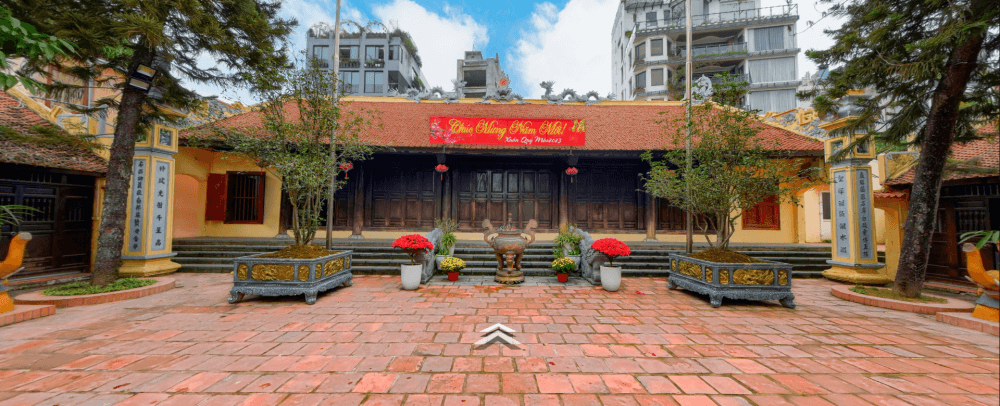

Introduce
Quang Ba communal house is located in Quang Ba Village, Quang An Ward, Tay Ho District, Hanoi. Quang Ba is an ancient village of Thang Long Ly - Tran, according to the text in Han script is still in the communal house and the words of the elderly in the village, the Hoang and the Le are the earliest families to settle in the land.
The Ngo, Vu and Nguyen families are coming later. The villagers live mainly by farming. Later, they plant flowers, ornamental plants, and marinated lotus tea. The village has three smaller groups: Giap Tho, Giap Le, Giap An.
Quang Ba is one of the three hamlets of Quang An commune, before 1942, three communes of Nghi Tam, Quang Ba and Tay Ho, belonging to Thuong, Hoan Long district, Ha Dong province. After 1942 all three communes entered into "Hanoi Special Agent". During the war against France (1946 - 1954), Quang Ba together with Nhat Tan Commune became Quang Tan. In 1955, three communes in Quang Ba district, outside Hanoi.
From 1961, it was named Quang An Commune, Tu Liem District. In 1996, Quang An changed into Quang An Ward, Tay Ho District.
According to legend, in the 18th century, when the troops came down to attack Tong Binh led by the Cao Chinh Binh Governor, Phung Hung was stationed in Quang Ba. The villagers set up a temple and later worshiped him as the village god with the name Bo Cai Dai Vuong.
The history and merits of the god is described as follows: Phung Hung is a large historical figure of our nation in the eighth century. He led the people of the country to regain national independence for more than seven years. The story of this national hero is recorded in many histories and handed down widely among the people. "Viet Dien Linh” by Ly Chi Xuyen writes: "...Ancestors of Phung are mandarins in Duong Lam, rich and prestigious with people around the region. Phung Hung's brother, Phung Hai is very strong and can even carry heavy boats for ten miles. Then in the second half of the eighth century, Tang's dominance weakened. The war between the towns (the Tang Dynasty governed the frontier) and the court made the Tang dynasty weaker and weaker. The mandate of the junta and the mandarins is increasing, they arbitrarily levy taxes, taking the wealth of the people.
During the Dai Lich (776 - 779), the people's anger reached the top, exploited when soldiers in Tong Binh revolted against the colonists, Phung Hung launched a revolt to win independence, freedom for the nation.
The two brothers Phung Hung and Phung Hai led the insurgent army to own Duong Lam and then occupied a large area around Duong Lam, building a base against the enemy. At the advice of the leader Do Anh Han, his compatriot, Phung Hung went down to Tong Binh to cover Phu Thanh. Cao Chinh Binh troops out to attack but lose then worry sick then die. Phung Hung went to Tong Binh and organized long-term self-control. After Phung Hung died, many people wanted to set up Phung Hai to replace, but Bo Pha Can established Phung Hung’s son Phung An succession.
Phung An honors his father as Bo Cai Dai Vuong, built a tomb in the northwest of Tong Binh.
To remember the merits of Phung Hung, people of some villages located on the road to the enemy encirclement camp of the Duong Lam set up a temple for Bo Cai Dai Vuong and honored him as the village god.
Formerly Quang Ba has the name of Quang Bo but because of the abstinence the village's god so it was read as Quang Ba.
According to the people, Quang Ba communal house was built on Con Xa mound (Snake mound), about 1000m to the southwest, and 300m to the west of Long An pagoda. But because the land is not favorable, bad things often happen in the village. Young men are often aggressive, so the villagers asked geographers to view the earth and rebuild the communal house on the site today.
Quang Ba communal house is also a place to witness the historical events of the nation in general and of the locals in particular.
Before the Revolution of August 1945, the communal house was a place of movement, meetings, and activities of revolutionary cadres. Based on the position of the communal house located near the West Lake between two Nhat Tan - Nghi Tam so officers from the Red River through Nhat Tan pass the sand yard to the communal house, and follow the West Lake into the inner city.
On the day of the August Revolution, the communal house was used as a meeting place, meeting for the administration, the headquarters of the Resistance Administrative Committee, and focus on protecting the village. On September 29, 1962, Uncle Ho visited the and kindly advised people to emulate labor, launching the movement to prevent epidemic, keep the village clean. The leaders of the Party and Nation also visited the communal house such as Comrade Vo Nguyen Giap, Pham Van Dong, Hoang Anh...
Quang Ba communal house dating very early, surviving so far has been repaired many times with the largest restoration in Bao Dai’s reign (1936).
At present, the architectural scale of the communal house includes: main temple, brick yard, two tombs, communal house gate and harem.
In front of the communal house is West Lake, next to the square well. Through the well is a small garden to the village road, next to the communal house gate is a pillar with cylindrical style, the top of the pillars embossed phoenix shape, the body to create a prominent foothold, on the body to record the Han sentence.
Two small ports on the sides of the arch. Large terrace, Bat Trang paved. Two tamarins on each side of the yard, each row of six walls built in the style of the director, roof tile roof. The roof rafter makes the racquet type simple. These two blocks serve as a meeting place for the armors when the village festival occurred.
The seven-room building, built in the style of the wall, the roof of the tile roof, the coast of the nail embankment, the Rahu and the sun are in the middle of the roof, two heads to embellish the clouds to form the dragon. In front of the two pillars are two pillars. The house is 45 cm above the ground.
The roof frame consists of six sets of trusses for the style of "gong". The interior of the six rows of wooden posts supporting the roof, the wooden posts placed on the smooth blue stone feet. Bat Trang brick flooring. Simple architecture, mainly focused on flower relief leaves, frogs, leopards, axes are sculptured.
The five-room harem was built with a wall-type retreat, roof tile roof, between the roof of the gourd wine and the dragon fish. Opened two arched arches.
At present, Quang Ba communal house also collects valuable collections of art history such as a Han scripture, 16 edicts, in which the earliest date of the sixth Canh Tri period (1670). The earliest date is the ninth year of Khai Dinh (1924).
An ancient stone inscription of the first reign (1841) records the history of the genie, the seven dragon saplings, dragon touches and two incense concave carvings (dragon, unicorn, turtle, phoenix) 17th and 18th century art, 17th century palanquin, a palanquin of the nineteenth century, four lacquered boards, three pairs of parallel sentences, lacquer, two hammocks, one bell, one gong and other worship items such as incense bowls, ceramic jars, cloths for worshiping...
Quang Ba communal house is a place of worship of the national hero wrote on the page history of foreign invasion of our nation in the eighth century.
The uprising led by Phung Hung took place in a very long time, but the overwhelming will of the leader and the insurgents and the glorious victories of the uprising were all nourished for the national spirit. For a period of intense struggle to gain independence and autonomy in later centuries.
Quang Ba communal house was classified as a Historical-Cultural relic on October 2, 1991. To preserve and promote the effect of the relic, for many years, the attention of the authorities and personnel local people, the house has been restored, embellished on a spacious, clean and beautiful to welcome visitors from all regions to visit, enjoy.
Artifacts
Map
Nearby Places
No. 43C, alley 497, quarter 2, group 15, Lac Long Quan Street, Nhat Tan Ward
1.33Km
No.6, Lane 319, An Duong Vuong Street, Phu Thuong ward
3.24Km
Lane 242, Lac Long Quan Street, Buoi Ward, Tay Ho District, Hanoi.
No. 20, Lane 472, Cluster 3, Lac Long Quan Road, Nhat Tan Ward, Tay Ho District, Hanoi.
No. 35, Lane 416, Lac Long Quan Road, Nhat Tan Ward, Tay Ho District, Hanoi.
2.57Km
No. 07, Lane 30, Tay Ho Road, Quang An Ward, Tay Ho District, Hanoi.
0.09Km
Residential Area No. 5 (No. 3, Lane 200, Au Co Road), Tu Lien Ward, Tay Ho District, Hanoi.
0.68Km
Residential Area No. 5 (No. 3, Lane 200, Au Co Road), Tu Lien Ward, Tay Ho District.
0.91Km